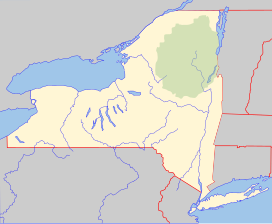geo.wikisort.org - Mountains
Mount Van Hoevenberg is a summit point located in the Adirondack Mountains in the Town of North Elba, Essex County, New York, 9 miles (15 km) east-southeast of the village of Lake Placid. Named for Henry Van Hoevenberg (1849–1918) (not to be confused with the American football player Henry Van Hoevenberg), it is best known for the location of the bobsleigh, luge, and skeleton track, and of a network of cross-country ski trails. The Mount Van Hoevenberg sports complex was used to host the 1932 (bobsleigh) and 1980 Winter Olympics (bobsleigh, luge, cross-country skiing, and biathlon).
| Mount Van Hoevenberg | |
|---|---|
 Mount Van Hoevenberg Location of Mount Van Hoevenberg within New York  Mount Van Hoevenberg Mount Van Hoevenberg (the United States) | |
| Highest point | |
| Elevation | 2,939 ft (896 m)[1] |
| Prominence | 627 m (2,057 ft)[1] |
| Coordinates | 44°12′36″N 73°55′46″W[2] |
| Geography | |
| Location | North Elba, Essex County, near Lake Placid, New York, U.S. |
| Parent range | Adirondack Mountains |
| Topo map | USGS North Elba |
Mount Van Hoevenberg stands within the watershed of the West Branch of the Ausable River, which drains into Lake Champlain, thence into Canada's Richelieu River, the Saint Lawrence River, and into the Gulf of Saint Lawrence. The southwest slopes of Mt. Van Hoevenberg drain directly into the West Branch. The northern and southern slopes of Van Hoevenberg drain into the North and South Meadow Brooks, respectively — tributaries of the West Branch.
The mountain is part of the Olympic Regional Development Authority (ORDA). ORDA maintains the cross-country ski and biathlon trail system originally used in the 1980 Olympics.
During the summer, the mountain is used for hiking and mountain biking.
References
- "Van Hoevenberg, Mount". ListsOfJohn.com. Retrieved 2013-02-22.
- "Mount Van Hoevenberg". Geographic Names Information System. United States Geological Survey, United States Department of the Interior. Retrieved 2013-02-22.
External links
- "Mt. VanHoevenberg". SummitPost.org.
- "The History of Mount van Hoevenberg Ski Area". The New York State Ski Blog.
- "Van Hoevenberg Trail". Trails.com
Другой контент может иметь иную лицензию. Перед использованием материалов сайта WikiSort.org внимательно изучите правила лицензирования конкретных элементов наполнения сайта.
WikiSort.org - проект по пересортировке и дополнению контента Википедии

